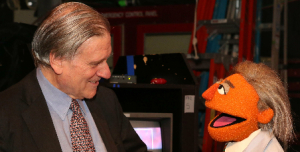by
Carol Ko, Staff Writer | March 14, 2013

Dr. Fuster and his Muppet character,
Dr. Ruster.
Thousands of cardiologists around the world gathered at the 62nd American College of Cardiology Scientific Sessions, the largest cardiology conference in the Americas, this past weekend March 9-11 in San Francisco.
Along with ongoing concerns such as dose reduction, other hot topics on everyone's mind included advanced imaging techniques, increased web access and Sesame Street. Yes, you heard right. Without further ado, here they are:
1. Sesame Street



Ad Statistics
Times Displayed: 109208
Times Visited: 6638 MIT labs, experts in Multi-Vendor component level repair of: MRI Coils, RF amplifiers, Gradient Amplifiers Contrast Media Injectors. System repairs, sub-assembly repairs, component level repairs, refurbish/calibrate. info@mitlabsusa.com/+1 (305) 470-8013
In his keynote speech kicking off the conference, nationally renowned cardiologist Dr. Valentin Fuster, director of Mount Sinai Heart at the Mount Sinai Medical Center, made an impassioned case for helping patients long before they acquire the habits that lead to heart disease later on in life.
Citing statistics that show most of our habits as adults are formed in early childhood, he asked, "Why not promote health at ages three to five if heart disease is partly a behavior problem?" Fuster has teamed up with Sesame Street to create a new character — Dr. Ruster — for Spanish-speaking audiences, that educates kids on health.
2. Image fusion
During a Joint Imaging Symposium presentation on technology trends Dr. Neil J. Weissman singled out sophisticated imaging technology that superimposes two or more images together, including
Philips' new Echonavigator — one of the most buzzed-about product debuting at the show.
The live image-guidance tool fuses 3-D echocardiography with fluoroscopy X-ray, enabling doctors to see both soft tissue and catheters as they perform minimally invasive heart repairs. Such technology will become more and more essential as procedures become less invasive and increasingly complex, Weissman said.
3. Dose reduction
Dose reduction continues to be one of the most pervasive trends at the show — it's literally everywhere, in numerous sessions dedicated to dose reduction and in endless booth offerings touting lower dose use.
Toshiba's Aquilion CT, for example, features the industry's first 320-row detector able to capture the entire heart in one rotation, significantly cutting down on dose. And Siemens' new Artis Q.Zen angiography system detectors are made with crystalline silicon that helps reduce dose.
A few vendors — including GE, which debuted its new DoseMap software at the show — also offered dose visualization software that enables radiologists to monitor cumulative patient dose levels on a more precise, anatomical level. DOTmed reckons software like this will become the standard in the near future, if it isn't already.
4. Portability and access
"Lighter, sleeker, smarter" was another persistent refrain at the show. Esaote's latest ultrasound offering, My Lab Twice, is a traditional ultrasound cart system with a detachable "tablet". While the cart system is imaging a patient, the tablet can also be used to get an ultrasound quickly in another part of the hospital.
Fujifilm's new Synapse 3D aims to make clinicians' workflow easier with more integrated access to advanced visualization tools at the workstation. And many if not most manufacturers (GE's Centricity Cardio Enterprise, Digisonic's Digiview, McKesson's Horizon Cardiology, Siemen's Syngo Dynamics) now offer doctors web access to patient information and images anywhere, any time. Digison's ad shows a doctor lounging on a lush tropical beach while checking images on his laptop. While this may be a bit of a stretch, anything that promotes better work-life balance — a top concern among surgeons today — is sure to be of interest to cardiologists.

